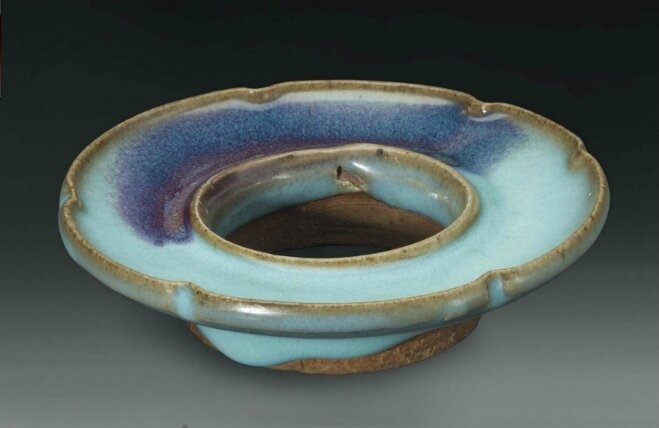A very rare purple-splashed Junyao hexalobed cup stand, China, Northern Song dynasty (AD 960-1127)
Lot 827. A very rare purple-splashed Junyao hexalobed cup stand, China, Northern Song dynasty (AD 960-1127); 4 7/8 in. (12.3 cm.) diameter. Estimate $50,000 - $70,000. Price Realized $665,000. Photo Christie's Image Ltd 2015
The hollow-centered cup stand covered with an opaque glaze of milky turquoise color splashed on one side in bluish and reddish purple and thinning to mushroom color on the raised inner, and outer, lobed rim, and then continuing onto the interior wall and the exterior where it falls in heavy drops onto the unglazed, reddish-brown circular foot.
Provenance: The Collection of Robert H. Ellsworth, New York, acquired in Hong Kong, 1988.
Note: The function of the cup stand is very similar to that of a saucer. As steaming bowls or cups of tea had no handles, they were placed on stands when served, so as not to burn the fingers of the recipient; in addition, stands provided a stable support for bowls which often had narrow bases. Extant examples of cup stands from the Song dynasty are found in both lacquer and different ceramic wares including Qingbai, Ru and Jun wares.
A green Jun lobed cup stand in the Palace Museum, Beijing, is illustrated in Zhongguo Taoci Quanji, Junyao (Jun Ware), vol. 12, Shanghai, 1983, no. 34. A Jun cup and a lobed cup stand in the Percival David Foundation are published by Stacey Pierson in 'Collecting Chinese Art - Interpretation and Display', Colloquies on Art & Archaeology in Asia, No. 20, London, 1999, pp. 34 and 39. Another lobed cup stand is in the Victoria & Albert Museum, museum no. CIRC. 151-1935.
Other ceramic examples include the Ru ware cup-stand with bow-shaped petals in the British Museum, illustrated by Jessica Rawson (ed.), The British Museum Book of Chinese Art, 1992, p. 244, fig. 179. The form can also be seen inQingbai wares depicted in a well-known late Song painting, Night Entertainment of Han Xizai, in the Palace Museum, Beijing, illustrated by Wu Hung, The Double Screen: Medium and Representation in Chinese Painting, p. 31, fig. 13.
Christie's. THE COLLECTION OF ROBERT HATFIELD ELLSWORTH PART IV - CHINESE WORKS OF ART: METALWORK, SCULPTURE AND EARLY CERAMICS, 20 March 2015, New York, Rockefeller Plaza.

/https%3A%2F%2Fprofilepics.canalblog.com%2Fprofilepics%2F1%2F0%2F100183.jpg)
/https%3A%2F%2Fstorage.canalblog.com%2F03%2F02%2F119589%2F96711876_o.jpg)
/https%3A%2F%2Fstorage.canalblog.com%2F11%2F31%2F119589%2F94773502_o.jpg)
/https%3A%2F%2Fstorage.canalblog.com%2F20%2F83%2F119589%2F94772815_o.jpg)
/https%3A%2F%2Fstorage.canalblog.com%2F26%2F72%2F119589%2F75604929_o.jpg)
/https%3A%2F%2Fstorage.canalblog.com%2F59%2F60%2F119589%2F26458628_o.jpg)



/http%3A%2F%2Fstorage.canalblog.com%2F05%2F64%2F119589%2F128523518_o.jpg)
/http%3A%2F%2Fstorage.canalblog.com%2F78%2F46%2F119589%2F127133605_o.jpg)
/http%3A%2F%2Fstorage.canalblog.com%2F99%2F82%2F119589%2F126892955_o.jpg)
/http%3A%2F%2Fstorage.canalblog.com%2F51%2F84%2F119589%2F122518624_o.jpg)